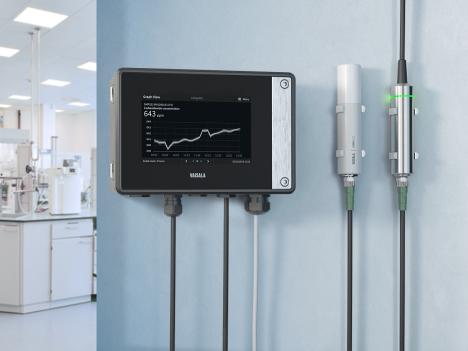In industrial applications like secondary battery manufacturing, controlling humidity is critical to ensuring product quality and preventing defects. The manufacturing process uses dehumidifier units (DHU) to ensure that the air circulating in the process meets strict specifications.
In battery production, maintaining extremely low humidity levels is critical, necessitating the use of large volumes of dry air. To achieve this, heating and drying the air effectively requires significant energy. The only way to optimize energy usage is to measure dew point and temperature and use these parameters to control the DHU.
The amount of heating required changes as the outside humidity changes. On humid days, increased heating is required, while on drier days, less heat is needed. However, the air supplied to the manufacturing areas must consistently maintain low humidity levels, regardless of the external conditions. So how can the dryness of the air blown in by the DHUs be kept at exactly the right level?
Accuracy and speed are essential
In battery manufacturing the sensors used to measure humidity must be extremely accurate: At a dew point of around -70 °C, there will only be 2.6 molecules of water in a million particles of air.
The rotating drums inside DHUs consist of two main parts:
- the drying section made of desiccant material that draws the moisture out of the air
- the regeneration section that drives heated air in the opposite direction to take moisture away from desiccant material
The segments typically rotate once every ten minutes or more If the moisture level of the incoming air is above the set limit, more heat is needed to remove the water molecules; if the moisture level is below the set limit less heat is necessary.
The sensor technology used must be able to measure humidity changes within the ten-minute window or the opportunity to adjust the heating for that rotation will have been missed.
To address this challenge, sensors that are too slow to detect rapid changes typically average out results from multiple readings to provide a more accurate measurement. The problem with this approach is that drying cannot be controlled in real time. Lack of control over drying leads to unstable humidity conditions, increased safety risks, and potential negative impacts on product quality.
Fast response time enables real-time control
Vaisala’s technology is unique by measuring humidity variations within one drum rotation, not just between rotations. This means that you can control the process in real time to maintain optimal dryness levels in each stage of production and prevent product defects.
Sensor response times are slower when air is dryer and faster at higher humidity levels. The extreme dryness required in the DHUs of battery plants makes it challenging to measure fast enough, meaning you risk relying on falsely high humidity readings.
In turn, this could lead to over-drying the air and wasting a significant amount of energy.
By accurately monitoring dew point with a response speed that can be as much as 20 times faster than some competing products, Vaisala’s sensors help to optimize the efficiency of the DHUs so that they only dry air as much as is necessary. This lowers both energy consumption and operational costs.
Beyond better control of humidity and costs, being able to see the whole signal from a single rotation has another benefit. By comparing accurate data from each cycle, you can spot small anomalies before they escalate into bigger problems. This supports predictive maintenance and condition-based maintenance, both of which further reduce operating costs – as well as headaches caused by potential product quality issues.
Vaisala dew point sensors are ideal for dehumidifier units
Vaisala sensors are particularly well-suited for measuring humidity in DHUs due to their accuracy, reliability, and fast response time.
The Vaisala Miniature Dew Point Transmitter DMT143 can measure dew point down to -70 °C, or 2.6 water molecules per million particles of air*. The sensor returns the results quickly so you can adjust the drying in real time in the DHU.
If you need even greater sensitivity, the Vaisala Dew Point Transmitter DMT152 can measure dew point down to -80 °C, or 0.5 parts per million of water per million particles of air.
Both sensors are compact and suitable for integration into DHU systems. Easy installation means minimal disruption, making it convenient for upgrades. These durable sensors are built for demanding industrial applications and require minimal maintenance. This level of reliability is essential in environments like battery manufacturing where sensor failure could compromise production quality and safety.
Other products suitable for secondary battery manufacturing processes are the Vaisala DRYCAP® Dew Point and Temperature Probe DMP7, made for tight spaces and low-humidity applications, and the DMP8, for industrial low-humidity applications.
The Dew Point and Temperature Probe DMP7 and Dew Point and Temperature Probe DMP8 are easy to install in ducts of various sizes, available with different probe nozzle lengths and cable options, and compatible with the Vaisala Indigo family – a customizable instrument platform designed to improve process measurements.
* The Vaisala DMT143 is capable to measure frost point temperature down to -70 °C, which corresponds to 2.6 µmol/mol or 2.6 ppm(v).
** The Vaisala DMT152 is capable to measure frost point temperature down to -80 °C, which corresponds to 0.5 µmol/mol or 0.5 ppm(v).
